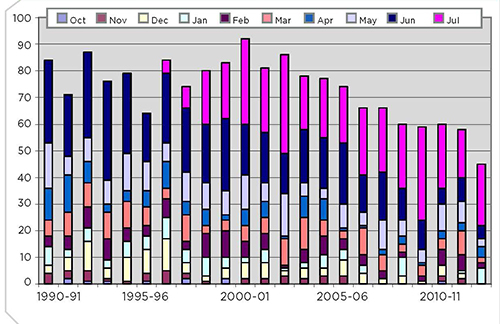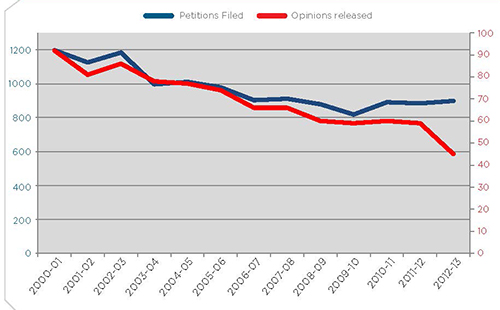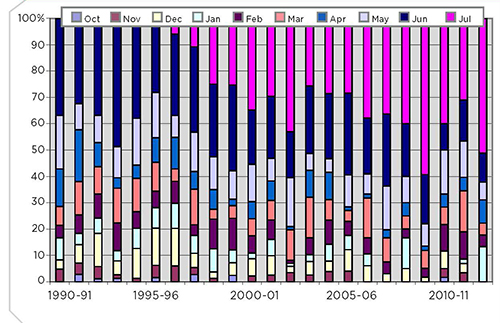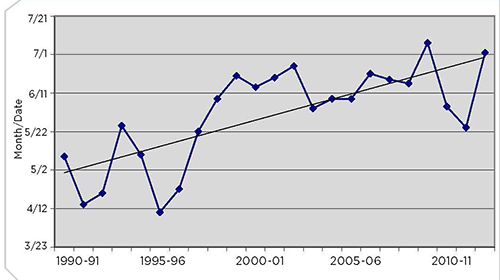The fact that most immediately stands out about the Wisconsin Supreme Court’s 2012-13 term is the marked drop in decided cases. Counting only dispositive opinions (eliminating attorney discipline cases and reconsiderations), the court released only 45 opinions, a drop of 24 percent from the previous term.
Figure 1: Number of Opinions By Term
As demonstrated in Figure 1, caseloads have been declining over the last 12 years, but they had leveled off to just under the 60 mark for the past four terms.
Figure 1
Cases by Month

Figure 2: Petitions and Cases
The 2012-13 term’s precipitous drop in opinions cannot be explained by a decline in the number of petitions requesting the court hear a case. As Figure 2 shows,1 the total number of petitions (counting petitions for review, petitions for bypass, certifications, petitions for supervisory writs, and original actions) filed each term has remained nearly the same for the past three terms.
Nor can the long-term trend of declining opinions be wholly explained by a decline in petitions. Although petitions and opinions declined at roughly the same rate for the first half of the last decade, petitions have leveled off since the 2006-07 term, but opinions have continued to drop.
Figure 1 also breaks down the number of opinions released in each month of the term. For the first time in at least 22 years, in the 2012-13 term no opinions were released until January.
Figure 2
Comparison of Petitions and Cases

Figure 3: Cases by Month
Changing the same information to reflect the number of opinions released in each month as a percentage of the total opinions released in the whole term (Figure 3) shows that more than half of the 2012-13 term’s opinions were released in July, a greater percentage than in any term except 2009-10.
Figure 3
Cases by Month as a Percentage of Total

Figure 4: Median Release Date
Another way of looking at the same information is to track the median release date (Figure 4), which also confirms that the 2012-13 term was the second slowest in recent years.
The combination of fewer opinions and slower releases is troubling. In a term in which the court heard so few cases, why did it take so long to release them? Hearing fewer cases means less time spent reading briefs; preparing for oral arguments; drafting and revising opinions, concurrences, and dissents; and meeting in conference to discuss the draft opinions. The court started hearing oral argument in September, just as it did in every other term, so with fewer opinions to write, the opinions should have come out sooner.
Figure 4
Median Release Date by Term

Voting Patterns
In the 2012-13 term, 40 percent of the 45 cases were unanimous,2 down from the previous term and below the average for the last 10 terms.
Of the 45 opinions, 18 were unanimous, nine had a single dissent, nine had two justices in dissent, and nine had three justices in dissent. Nine 4-3 cases is typical for a single term (with the notable outlier of the 2011-12 term, which saw only four 4-3 opinions) in terms of absolute numbers, but represents a significant percentage increase, with 24 percent fewer total opinions in the 2012-13 term. The number of 4-3 cases would be larger if we counted two opinions, Rosecky v. Schissel (In re F.T.R.)3 and State v. Alexander,4 in which the justices all agreed with the ultimate result but split 4-3 on which rule the court should adopt to reach that result.
Figure 5: Cohesion of Justices
Figure 5 lists the cohesion of each justice with each other justice, that is, how frequently the two justices voted for the same result, regardless of reasoning.5
These patterns largely track those of the 2011-12 term, with two notable differences.
First, in the 2012-13 term, the extremes were mildly tempered, with justices at the two ends of the ideological spectrum agreeing with each other more often than in the previous term. This trend was particularly noteworthy in the 4-3 cases, in which no two justices agreed with each other in all nine cases. While two pairings (Abrahamson-Ziegler, Bradley-Gableman) never agreed in those close cases, that is still a substantial tempering from the 2011-12 term, during which Justice Roggensack, Justice Ziegler, and Justice Gableman never agreed with Chief Justice Abrahamson, Justice Bradley, and Justice Crooks in close cases.
Figure 5
Cohesion of Justices
All Opinions (45 total)
| |
Abrahamson |
Bradley |
Crooks |
Prosser |
Roggensack |
Ziegler |
Gableman |
| Abrahamson |
|
93% |
73% |
62% |
58% |
53% |
55% |
| Bradley |
93% |
|
76% |
69% |
64% |
60% |
57% |
| Crooks |
73% |
76% |
|
74% |
84% |
80% |
81% |
| Prosser |
62% |
69% |
74% |
|
74% |
72% |
69% |
| Roggensack |
58% |
64% |
84% |
74% |
|
91% |
88% |
| Ziegler |
53% |
60% |
80% |
72% |
91% |
|
95% |
| Gableman |
55% |
57% |
81% |
69% |
88% |
95% |
|
Non-unanimous Opinions (27 total)
| |
Abrahamson |
Bradley |
Crooks |
Prosser |
Roggensack |
Ziegler |
Gableman |
| Abrahamson |
|
89% |
56% |
29% |
30% |
22% |
24% |
| Bradley |
89% |
|
59% |
43% |
41% |
33% |
28% |
| Crooks |
56% |
59% |
|
52% |
74% |
67% |
68% |
| Prosser |
29% |
43% |
52% |
|
52% |
50% |
45% |
| Roggensack |
30% |
41% |
74% |
52% |
|
85% |
80% |
| Ziegler |
22% |
33% |
67% |
50% |
85% |
|
92% |
| Gableman |
24% |
28% |
68% |
45% |
80% |
92% |
|
Close Opinions (4-3, 9 total)
| |
Abrahamson |
Bradley |
Crooks |
Prosser |
Roggensack |
Ziegler |
Gableman |
| Abrahamson |
|
89% |
78% |
56% |
11% |
0% |
11% |
| Bradley |
89% |
|
67% |
67% |
22% |
11% |
0% |
| Crooks |
78% |
67% |
|
67% |
33% |
22% |
33% |
| Prosser |
56% |
67% |
67% |
|
33% |
44% |
44% |
| Roggensack |
11% |
22% |
33% |
33% |
|
89% |
78% |
| Ziegler |
0% |
11% |
22% |
44% |
89% |
|
89% |
| Gableman |
11% |
0% |
33% |
44% |
78% |
89% |
|
Criminal Cases (19 total)
| |
Abrahamson |
Bradley |
Crooks |
Prosser |
Roggensack |
Ziegler |
Gableman |
| Abrahamson |
|
89% |
58% |
53% |
47% |
47% |
47% |
| Bradley |
89% |
|
68% |
67% |
58% |
58% |
59% |
| Crooks |
58% |
68% |
|
80% |
89% |
89% |
94% |
| Prosser |
53% |
67% |
80% |
|
87% |
80% |
85% |
| Roggensack |
47% |
58% |
89% |
87% |
|
89% |
93% |
| Ziegler |
47% |
58% |
89% |
80% |
89% |
|
100% |
| Gableman |
47% |
59% |
94% |
85% |
93% |
100% |
|
Civil Cases (26 total)
| |
Abrahamson |
Bradley |
Crooks |
Prosser |
Roggensack |
Ziegler |
Gableman |
| Abrahamson |
|
96% |
85% |
67% |
65% |
58% |
60% |
| Bradley |
96% |
|
81% |
71% |
69% |
62% |
56% |
| Crooks |
85% |
81% |
|
71% |
81% |
73% |
72% |
| Prosser |
67% |
71% |
71% |
|
67% |
67% |
65% |
| Roggensack |
65% |
69% |
81% |
67% |
|
92% |
84% |
| Ziegler |
58% |
62% |
73% |
67% |
92% |
|
92% |
| Gableman |
60% |
56% |
72% |
65% |
84% |
92% |
|
Figure 6: 4-3 Majority Makeups
In general, close opinions saw a greater variety of vote lineup than in previous years (Figure 6). No justice was in the majority in more than six of those nine cases.
This moderating effect is also reflected in how frequently each justice was in the majority. The five justices who were in the majority more than 90 percent of the time in the previous term all dropped in majority participation this term, while the two other justices joined the majority more frequently.
The second notable difference from the previous term was Justice Prosser’s dramatic turn toward independence. Leaving his historical position as a solid member of the court’s conservative bloc, during the 2012-13 term he was as likely to vote with Justice Crooks and Justice Bradley (74 percent and 69 percent, respectively) as with Justice Roggensack, Justice Ziegler, and Justice Gableman (74 percent, 72 percent, and 69 percent, respectively). By comparison, in the previous term, he voted with Justice Crooks, Justice Roggensack, Justice Ziegler, and Justice Gableman more than 90 percent of the time, but with Justice Bradley only 60 percent of the time and with Chief Justice Abrahamson only 46 percent of the time.
Justice Prosser also penned the most solo dissents, four, of any justice in the 2012-13 term, a distinction that typically has gone to Chief Justice Abrahamson. Three6 of those four cases revolved around statutory interpretation, while the fourth7 was a dispute concerning a contract.
Justice Crooks dissented in only three cases, displacing Justice Prosser as the justice most often in the majority.
Other voting patterns continue. For example, Chief Justice Abrahamson and Justice Bradley remain likely to form a two-justice dissenting bloc in criminal cases. Of the 12 non-unanimous criminal decisions, Chief Justice Abrahamson and Justice Bradley formed a two-justice minority in five and dissented together in both 4-3 criminal cases. They disagreed in only two of the 19 criminal cases.
Finally, the two least senior members (Justice Ziegler and Justice Gableman) and the two most senior members (Chief Justice Abrahamson and Justice Bradley) were the two pairs in most agreement with each other, at 95 percent and 93 percent, respectively (see Figure 5).
Figure 6
4-3 Majority Makeups
| # Cases |
Vote Lineup |
| 3 |
Abrahamson, Bradley, Crooks, Prosser |
| 2 |
Prosser, Roggensack, Ziegler, Gableman |
| 2 |
Crooks, Roggensack, Ziegler, Gableman |
| 1 |
Abrahamson, Bradley, Crooks, Roggensack |
| 1 |
Bradley, Prosser, Roggensack, Ziegler |
Conclusion
Will these trends continue? Only time will tell, but the early results from the ongoing 2013-14 term are promising. Four opinions were released in the first calendar year of the term, compared to none the previous term. As far as voting patterns go, almost all of the opinions have been unanimous – although the court did issue a per curiam affirmance of the court of appeals in which it split 3-3 along familiar lines in an economic loss doctrine case, with Justice Prosser recusing himself.8
Endnotes
1 Before the 2006-07 term, Wisconsin Supreme Court statistical reports were calculated on a calendar-year basis instead of by term. Therefore, for the first six terms shown in Figure 2, the number of petitions filed is measured over a different period than the number of opinions released. However, the overall trend remains clear.
2 Throughout this analysis, concurrences are ignored except where explicitly discussed, regardless of whether justices writing and joining concurrences also joined the majority opinion. Thus, for example, Rosecky v. Schissel (In re F.T.R.), 2013 WI 66, 349 Wis. 2d 84, 833 N.W.2d 634, is counted as a unanimous opinion, even though Chief Justice Abrahamson and Justice Bradley and Justice Crooks concurred without joining the majority opinion written by Justice Ziegler. A dissent in part is counted a concurrence if that justice reached the same ultimate result as the majority.
3 Rosecky v. Schissel (In re F.T.R.), 2013 WI 66, 349 Wis. 2d 84, 833 N.W.2d 634.
4 State v. Alexander, 2013 WI 70, 349 Wis. 2d 327, 833 N.W.2d 126.
5 Using the same counting methodology, Justice Bradley and Justice Ziegler would be considered as voting together in Rosecky.
6 State v. Neumann, 2013 WI 58, 348 Wis. 2d 455, 832 N.W.2d 560; Johnson v. Masters, 2013 WI 43, 347 Wis. 2d 238, 830 N.W.2d 647; Marlowe v. IDS Prop. Cas. Ins. Co., 2013 WI 29, 346 Wis. 2d 450, 828 N.W.2d 812.
7 Tufail v. Midwest Hospitality LLC, 2013 WI 62, 348 Wis. 2d 631, 833 N.W.2d 586.
8 State Farm Fire & Cas. Co. v. Hague Quality Water, Int’l, 2014 WI 5, 352 Wis. 2d 308, 841 N.W.2d 819.
